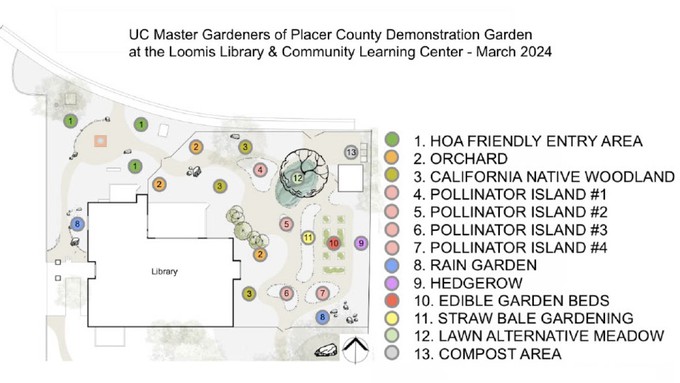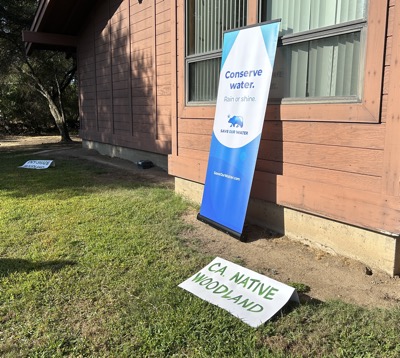
Master gardeners to unveil water-wise showcase at Loomis Library

This map shows the various planting areas for the new demonstration garden. Courtesy Placer County master gardeners
Gardeners learn by example. And soon local residents will have a new resource to see the best ways to grow vegetables and herbs, how to fit fruit into a small landscape, and which plants attract pollinators while saving water. It’s a collection of real-life lessons in water-wise gardening, right next to a Community Learning Center.
On Wednesday, March 27, the UC Cooperative Extension Master Gardeners of Placer County will officially open their demonstration garden outside the Loomis Library. The public is welcome to attend the 11 a.m ribbon cutting and Open Garden, which continues until 1 p.m. Admission and parking are free.
Officially named the “UC Master Gardeners of Placer County Demonstration Garden at the Loomis Library and Community Learning Center,” the new garden replaces more than 11,000 square feet of lawn that had wrapped around the facility. Loomis Library is located at 6050 Library Drive, Loomis.
“This is one-third acre,” says master gardener Karen Lopez, the garden’s coordinator. “The library is in the heart of Loomis, less than a half mile off Interstate 80. … There was a lot of land around the library and it was just turf. Someone suggested, ‘What if we put in a few garden beds?’”
That was more than four years ago, back during California’s prolonged drought. Coincidentally, the Placer County master gardeners were looking for a site for a centrally located demonstration garden.
In 2021, the master gardeners and Loomis Library formalized the garden plan with a memorandum of understanding. That led to drawing up designs, finding funding and then the ground-breaking last fall.
“The garden really adds a lot to the library,” Lopez notes. “It’s a Community Learning Center, and that’s what we’re all about, too.”
Master gardener Karen Covey spearheaded the project through construction and planting. Crews of Placer County master gardeners spent fall planting California natives and pollinator plants, which benefited from winter rain.
“The timing was just perfect,” Lopez says.
Just six months after ground-breaking in September, the new demonstration garden will be open during the library’s regular hours. Currently, that’s five days a week: 1 to 7 p.m. Tuesdays and 10 a.m to 5 p.m. Wednesdays through Saturdays. Signage explains what’s happening in each planting bed, naming the species and varieties as well as other notes.
“We have QR codes on every plant,” Lopez says.
The garden also will serve as a classroom. The master gardeners will staff the garden with docents the second Saturday of each month. That same day, they’ll host free workshops and speakers, open to the public.
As its name implies, the demonstration garden will show how to grow a water-wise and wildlife-friendly garden that looks good year-round while attracting pollinators such as butterflies and bees as well as supporting birds. The garden also provides space to grow vegetables, fruit, berries and herbs as part of educational displays.
“We even have a small orchard,” Lopez adds. “We want to showcase fruit trees that don’t need to be 10 feet tall to produce good fruit.” That includes apples and pears, trained on trellises, and other fruit trees grown in large pots.

Besides offering a living showcase of the master gardeners’ work, the project will save a significant amount of water by the replacement of all that old lawn. The Placer County Water Agency contributed about $10,000 in rebates and incentives for turf removal and irrigation upgrades. Wood chips and compost for the new garden were provided by the Town of Loomis.
The Friends of the Loomis Library raised money for the garden through a “Buy a Brick” campaign; the engraved bricks are part of a permanent garden display. You can support the garden by purchasing an engraved brick at https://www.polarengraving.com/floomisl. The bricks cost $120 ($130 with logo).
Contributions are still being accepted. Donate directly to the master gardeners at www.pcmg.ucanr.edu.
After Wednesday’s ceremony, the first big event will be the garden’s Spring Open House, 10 a.m. to 2 p.m. June 1.
“The plants will be really showy by then,” Lopez says. “The ribbon cutting will be fun, but the garden will look fantastic in June.”
Comments
0 comments have been posted.Sacramento Digs Gardening to your inbox.
Sites We Like
Garden Checklist for week of July 21
Your garden needs you!
* Keep your vegetable garden watered, mulched and weeded. Water before 8 a.m. to reduce the chance of fungal infection and to conserve moisture.
* Feed vegetable plants bone meal, rock phosphate or other fertilizers high in phosphate to stimulate more blooms and fruiting. (But wait until daily high temperatures drop out of the 100s.)
* Don’t let tomatoes wilt or dry out completely. Give tomatoes a deep watering two to three times a week.
* Harvest vegetables promptly to encourage plants to produce more. Squash especially tends to grow rapidly in hot weather. Keep an eye on zucchini.
* Pinch back chrysanthemums for bushy plants and more flowers in September.
* Remove spent flowers from roses, daylilies and other bloomers as they finish flowering.
* Pinch off blooms from basil so the plant will grow more leaves.
* Cut back lavender after flowering to promote a second bloom.
* It's not too late to add a splash of color. Plant petunias, snapdragons, zinnias and marigolds.
* From seed, plant corn, pumpkins, radishes, winter squash and sunflowers.